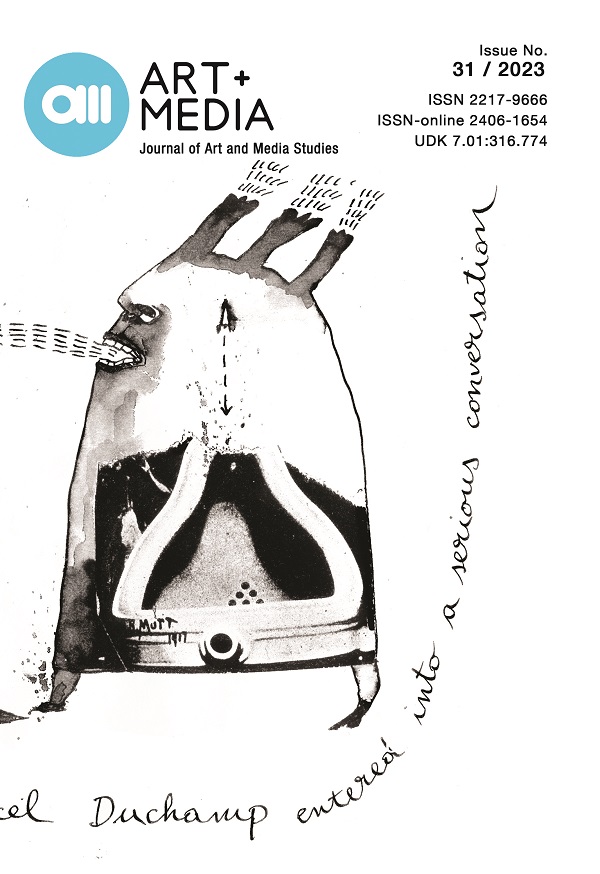How Male Gaze Can Influence the Perception of Art Pieces from the Psychiatric Art Collection of the Hungarian Academy of Sciences? (Case Study)
DOI:
https://doi.org/10.25038/am.v0i29.573Keywords:
femme-fatale; identity; being a woman outsider artist; male gaze; PsyArt Collection of the Hungarian Academy of Sciences.Abstract
The objective of this paper is to comprehend the environmental impact, specifically the influence of the psychiatric institution, on a work of art created within the context of psychiatric treatment. Additionally, the paper focuses on exploring the artwork’s impact on the viewer, and examining how we perceive these drawings – whether as neutral observers or through a sexualized lens. The intention is to present a collection of artworks produced by a female patient during her hospitalization in the 1950s and 1960s at the National Institute of Psychiatry and Neurology in Budapest. For the purposes of this study, the artist has been given the pseudonym “Antonia”, as her identity is only known within the institutional records through her marital status, identification by her husband’s name, and an approximate age at the time of admission. Antonia’s drawings depict women engaged in various everyday situations, such as enjoying an elegant dinner or dancing, and also include portraits of a young, attractive, and sexually appealing individual. When interpreting these drawings, it is impossible to avoid being influenced by the perspective from which the figures, seemingly vulnerable and exposed even in their elegant attire, offer their creator a glimpse into their emotions, anxieties, and fears. The aim of this study is to demonstrate that, even in contemporary times, decades after their creation, when approached from the perspectives of art history, psychology, and sociology, these drawings can only be accessed through the patriarchal lens that initially categorized them as part of the museum canon and included them in the collection during their respective era. Departing from this foundational standpoint proves to be a challenging endeavor.
References
Anzieu, Didier. Le moi-peau. Paris: Dunod, 2006.
Csabai, Márta and Ferenc Erős. Testhatárok és énhatárok. Az identitás változó keretei [Body Boundaries and Self-Boundaries: The Changing Frames of Identity]. Budapest: Jószöveg Műhely, 2000.
Darida, Veronika. Hisztériák [Hysterias]. Budapest: Kijárat, 2012.
Mireille Dottin-Orsini. Cette femme qu'ils disent fatale: textes et images de la misogynie fin-de-siècle [This Woman They Called Fatale]. Paris: Grasset, 1993.
Faludy, Judit. “A testkép szerepe a kreativitásban – Egy tárgycsoport kontextualizálási kísérlete [The Role of Body Image in Creativity – An Attempt to Contextualize a Group of Objects].” Psychiatria Hungarica 30, 2 (2015): 167–177.
Judit Faludy Nővész&történet [The title is a kind of wordplay], Látkép 2021 – Művészettörténeti tanulmányok [Látkép 2021 Conference Papers in Art History] Látkép 09 – Kortárs elméletek [View from 09 – Contemporary theories] (Budapest: BTK MI, 2022) : 481–490.
Jill Storr, Melinda. “The Gaze in Theory: The Cases of Sartre and Lacan.” Ph.D. diss., University of York, Centre for Women’s Studies, 1994.
Lambert, Gisèle. “Image de calendrier. ‘Beauté sautant dans le vide depuis le balcon du temple KiyomIzu’.” https://essentiels.bnf.fr/fr/image/cd7e6faa-d7c1-466f-8441-c9ad5c53e886-image-calendrier-1. Accessed on March 27, 2023
Lewis Herman, Judith. Trauma és gyógyulás – Az erőszak hatása a családon belüli bántalmazástól a politikai terrorig [Trauma and Recovery: The Aftermath of Violence – from Domestic Abuse to Political Terror], trans.: Kuszing Gábor. Budapest: Háttér – Kávé – NANE Egyesület, 2011.
McCrea, Celia W., Angela B. Summerfield, and Bernard Rosen. “Body image: a selective review of existing measurement techniques,” British Journal of Medical Psychology 55, 3 (1982): 225–232. https://doi.org/10.1111/j.2044-8341.1982.tb01502.x DOI: https://doi.org/10.1111/j.2044-8341.1982.tb01502.x
Pascal, Blaise. Pensées, Tome I. Paris: Hachette, Tome 1, 1871. English translation: Jonathan Bennett, 2017. https://www.earlymoderntexts.com/assets/pdfs/pascal1660.pdf. Accessed on March 27, 2023
Tony Porter. “A call to men.” https://www.ted.com/talks/tony_porter_a_call_to_men. Accessed on July 11, 2023
Suleiman, Susan Rubin. “Judith Herman and Contemporary Trauma Theory.” Women’s Studies Quarterly 36, 1/2 (Spring – Summer, 2008): 276–281. DOI: https://doi.org/10.1353/wsq.0.0016
Szászi, Beáta and Pál Szabó. “A táncos test: egészség, testi elégedettség, testhez való viszony, evési attitűdök és önértékelés vizsgálata táncosok körében [Dancers’ Body: The Examination of Health, Body Satisfaction, Body Attitudes, Eating Attitudes, and Self-esteem among Dancers].” Tánc és Nevelés [Dance and Education] 2, 1 (2021): 4–29. https://doi.org/10.46819/TN.2.1.4-29 DOI: https://doi.org/10.46819/TN.2.1.4-29
Wojcik, Daniel. Outsider Art: Visionary Worlds and Trauma. Jackson: University Press of Mississippi, 2016.
Downloads
Published
How to Cite
Issue
Section
License
Copyright (c) 2023 AM Journal of Art and Media Studies

This work is licensed under a Creative Commons Attribution 4.0 International License.
The content on this site is licensed under a Creative Commons Attribution 4.0 International License.
AM Journal of Art and Media Studies ISSN 2217-9666 - printed, ISSN 2406-1654 - online, UDK 7.01:316.774
Contact: amjournal@outlook.com
Publisher: Faculty of Media and Communications, Singidunum University, Belgrade, Serbia
Indexed in: ERIH PLUS, EBSCO, DOAJ, and in The List of Scientific Journals Categorization of Ministry of Education, Science and Technological Development of Republic of Serbia (M24 in 2021; M23 in 2023). Beginning with No. 12 2017, AM is indexed, abstracted and covered in Clarivate Analytics service ESCI.

